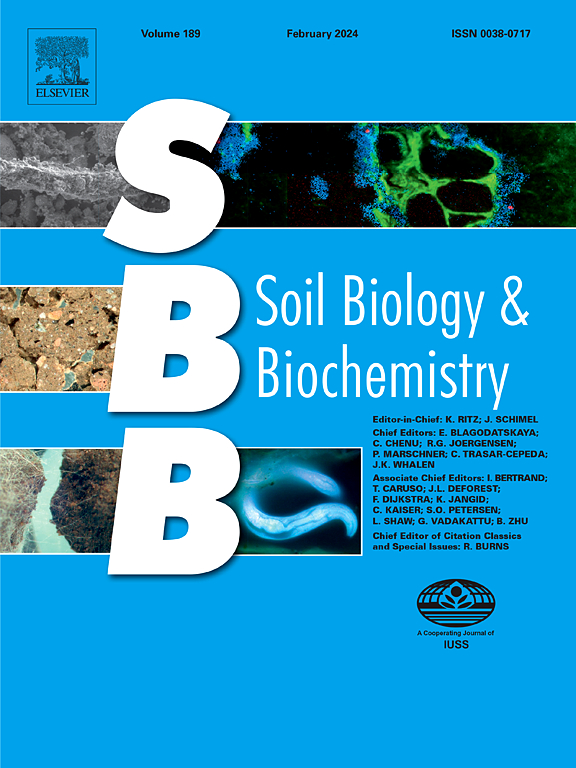Feasibility and limitations of using specific nitrification inhibitors to differentiate ammonia oxidizer activity
IF 9.8
1区 农林科学
Q1 SOIL SCIENCE
引用次数: 0
Abstract
The application of nitrification inhibitors targeting distinct ammonia-oxidizing guilds—complete ammonia oxidizers (comammox), ammonia-oxidizing archaea (AOA), and bacteria (AOB)—has facilitated elucidating their functional significance across diverse ecosystems. However, the specificity and reliability of these inhibitors remain controversial and have not been thoroughly evaluated. In this study, we first conducted a meta-analysis of several specific nitrification inhibitors: acetylene, 1-octyne, 3,4-dimethylpyrazole phosphate (DMPP), 2-phenyl-4,4,5,5-tetramethylimidazoline-1-oxyl-3oxide (PTIO), and chlorate, focusing on their effects on AOA, AOB and comammox Nitrospira. Acetylene broadly inhibited the growth of all ammonia oxidizers. Both 1-octyne and higher concentrations (≥1.5%) of DMPP exhibited dual regulatory effects: inhibiting the growth of AOB and comammox Nitrospira (clade B for 1-octyne; all clades for DMPP) while stimulating AOA growth. PTIO inhibited AOA and AOB but had no significant effect on comammox Nitrospira clade A growth. In contrast, chlorate specifically inhibited comammox Nitrospira growth. To assess the ecological relevance of these synthesized patterns, particularly the guild-specific effects, we conducted microcosm experiments. The results revealed that PTIO failed to inhibit AOA growth in wetland soil. The specificity of 1-octyne and chlorate is dose-dependent. Notably, chlorate at 10 mM completely inhibited the growth of all ammonia oxidizers, while its addition consistently stimulated soil nitrous oxide (N2O) emissions, indicating it cannot reliably differentiate the contribution of different nitrifier guilds to N2O emissions. These findings collectively challenge the conventional use of inhibitor-based assays, underscoring the necessity to evaluate the effectiveness of inhibitors in distinguishing the functional importance of ammonia oxidizers.使用特定硝化抑制剂区分氨氧化剂活性的可行性和局限性
硝化抑制剂针对不同氨氧化行业——完全氨氧化菌(comammox)、氨氧化古菌(AOA)和细菌(AOB)的应用,有助于阐明它们在不同生态系统中的功能意义。然而,这些抑制剂的特异性和可靠性仍然存在争议,尚未得到彻底的评估。在本研究中,我们首先对几种特定的硝化抑制剂乙炔、1-辛烷、3,4-二甲基吡唑磷酸(DMPP)、2-苯基-4,4,5,5-四甲基咪唑啉-1-氧基-3氧化物(PTIO)和氯酸盐进行了荟萃分析,重点研究了它们对AOA、AOB和comammox硝基螺旋菌的影响。乙炔广泛抑制氨氧化剂的生长。1-辛烷和较高浓度(≥1.5%)的DMPP均表现出双重调节作用:抑制AOB和comammox Nitrospira(1-辛烷B支系)的生长;所有分支为DMPP),同时刺激AOA的增长。PTIO对AOA和AOB有抑制作用,但对科莫克斯硝基螺旋藻A枝生长无显著影响。相比之下,氯酸盐特异性地抑制了科莫克斯硝化螺旋菌的生长。为了评估这些综合模式的生态相关性,特别是行会特异性效应,我们进行了微观实验。结果表明,PTIO对湿地土壤中AOA的生长没有抑制作用。1-辛烷和氯酸盐的特异性是剂量依赖性的。值得注意的是,10 mM氯酸盐完全抑制了所有氨氧化剂的生长,而其添加量却持续刺激了土壤氮氧化物(N2O)的排放,这表明它不能可靠地区分不同氮化物行业对N2O排放的贡献。这些发现共同挑战了传统的基于抑制剂的测定方法,强调了评估抑制剂在区分氨氧化剂功能重要性方面的有效性的必要性。
本文章由计算机程序翻译,如有差异,请以英文原文为准。
求助全文
约1分钟内获得全文
求助全文
来源期刊

Soil Biology & Biochemistry
农林科学-土壤科学
CiteScore
16.90
自引率
9.30%
发文量
312
审稿时长
49 days
期刊介绍:
Soil Biology & Biochemistry publishes original research articles of international significance focusing on biological processes in soil and their applications to soil and environmental quality. Major topics include the ecology and biochemical processes of soil organisms, their effects on the environment, and interactions with plants. The journal also welcomes state-of-the-art reviews and discussions on contemporary research in soil biology and biochemistry.
 求助内容:
求助内容: 应助结果提醒方式:
应助结果提醒方式:


